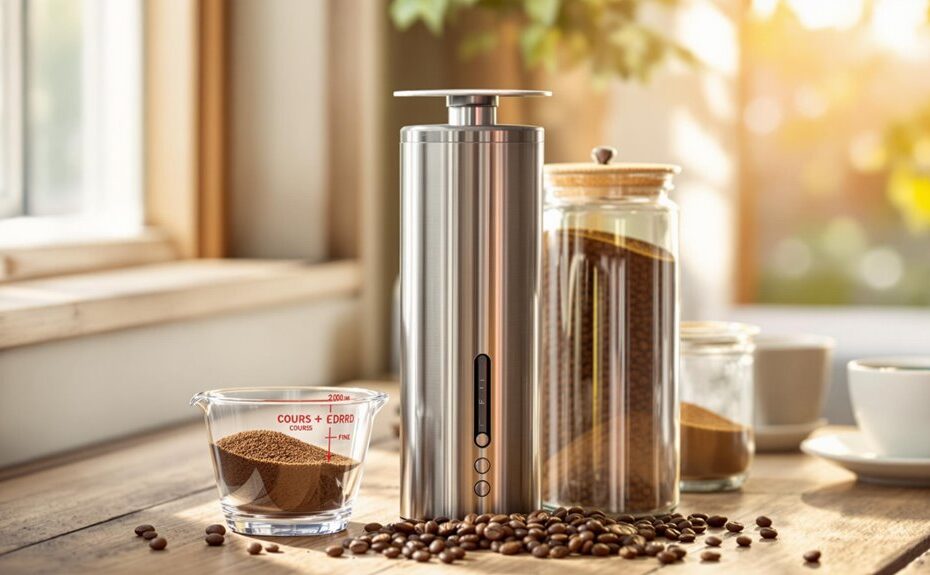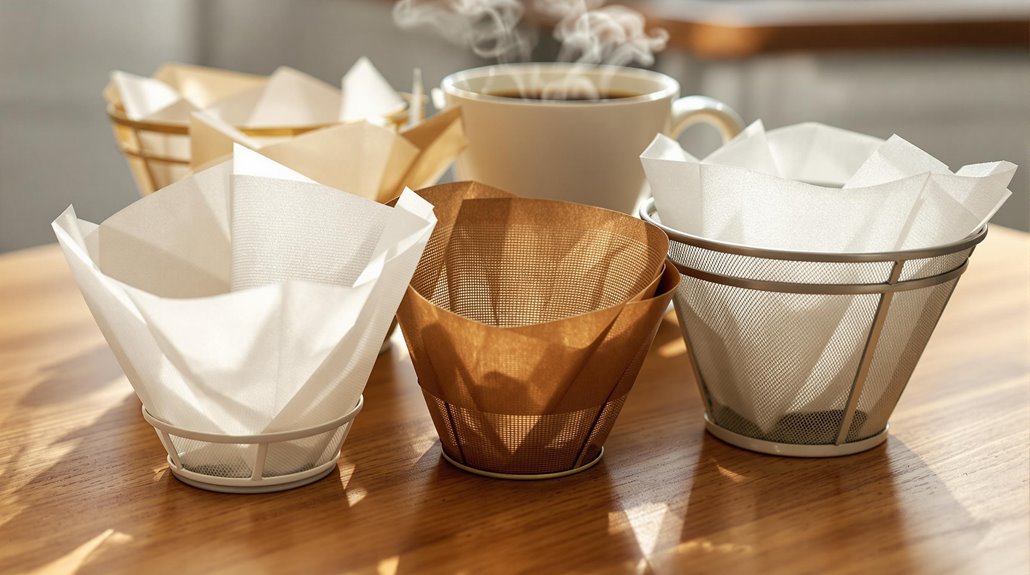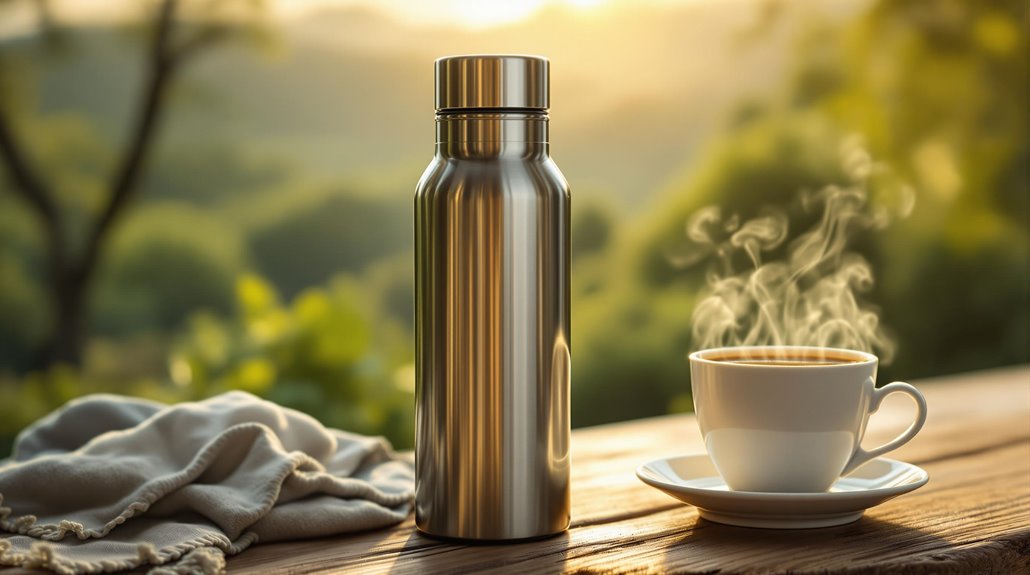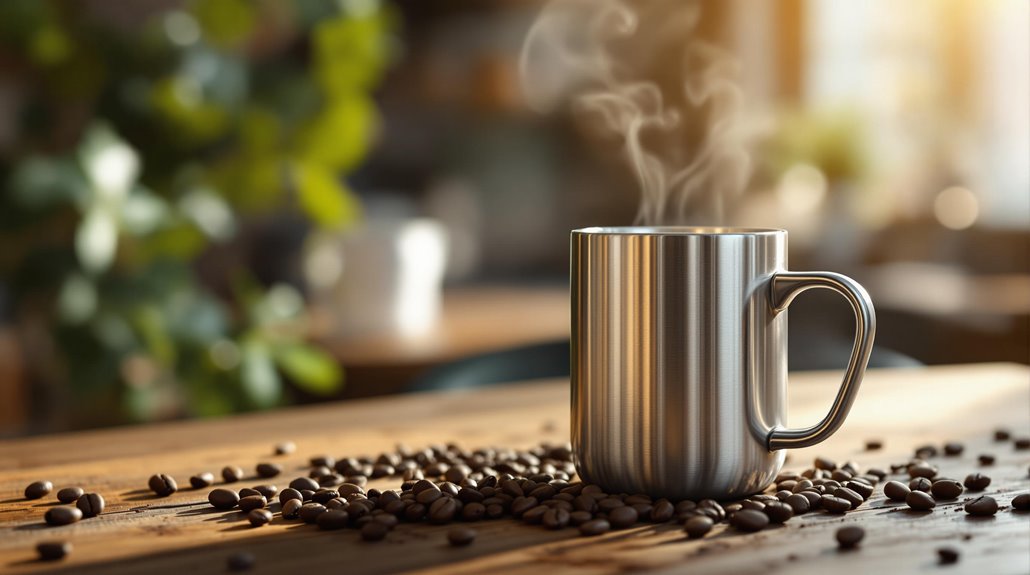







When you're selecting the right size for a coffee grinder, it's crucial to evaluate your brewing habits and how much coffee you typically consume. You might find that a grinder with a larger capacity suits your daily needs better, especially if you frequently entertain guests or enjoy multiple cups in a sitting. On the other hand, if your coffee ritual is more casual, a compact model could work just fine. But before you make a decision, it's important to explore other factors that could influence your choice, including grind consistency and maintenance requirements.
Key Takeaways
- Consider your daily coffee consumption; larger grinders are ideal for frequent brewers, while smaller ones suit occasional use.
- Match grinder capacity to your brewing method; 200-300 grams is typical for home use, ensuring enough for multiple servings.
- Evaluate the size of burrs; larger burrs grind faster and more consistently, beneficial for various brewing techniques.
- Assess available space; compact grinders are great for tight areas, while larger ones need more counter space.
- Determine whether you prefer manual or electric options; manual grinders are portable, while electric models handle larger batches efficiently.
Understanding Grinder Types
When selecting a coffee grinder, it's essential to comprehend the various types available, as each has its own benefits and limitations. The primary categories are burr and blade grinders. Burr grinders, available in flat and conical designs, excel at providing precise grind size control. Flat burr grinders use centrifugal force and typically last between 250-600 kg of coffee, while conical burr grinders, which feature a 60-degree cutting face, can last 750-1,000 kg, offering superior durability and consistency.
On the other hand, blade grinders are generally more affordable but are less reliable for achieving a uniform grind. They chop beans with spinning blades, resulting in inconsistent grind sizes that can lead to uneven extraction during brewing.
When it comes to materials, steel burrs are common in commercial grinders due to their heat conductivity, but they can lead to temperature fluctuations. Ceramic burrs, while more stable in temperature, tend to be more brittle. For specialty coffee brewing, conical burr grinders are often preferred for their durability and consistent grind quality, making them the ideal choice for serious coffee enthusiasts.
Importance of Grind Size
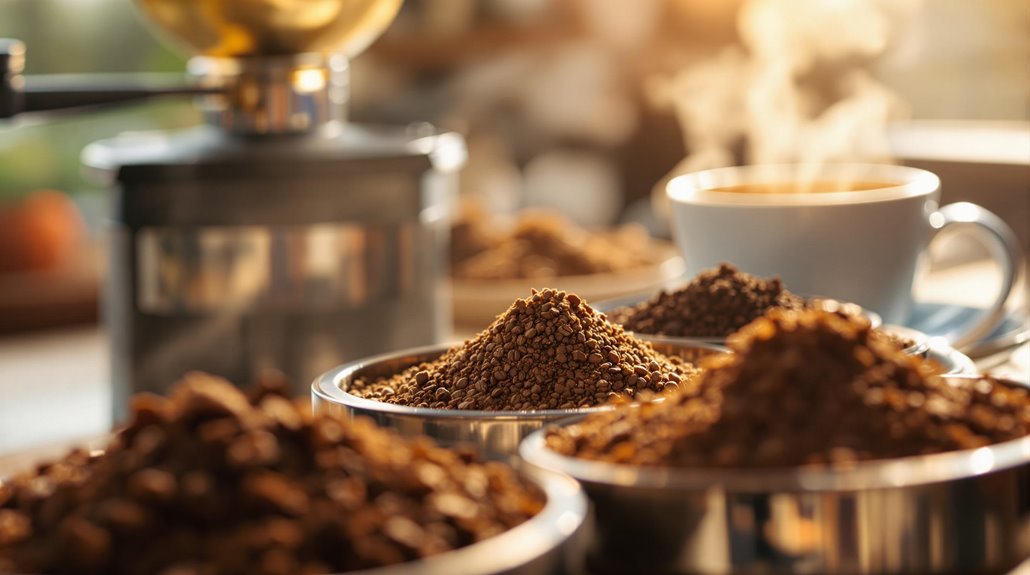
Selecting the right grinder type sets the stage for understanding the importance of grind size in coffee brewing. The grind size directly impacts extraction, which is key for flavor development. For instance, fine grinds, such as those used in espresso, require high pressure for ideal extraction, while coarse grinds, perfect for methods like French press, need longer steeping times to achieve the right flavor profile.
Achieving a consistent grind size is essential; inconsistent grind sizes can lead to uneven extraction, resulting in bitter and weak flavors in the same cup. For drip coffee makers like the Moccamaster, medium-coarse grinds, akin to sea salt, guarantee balanced extraction and ideal flow, preventing clogs and overflow.
Matching the grind size to your brewing method is critical. Fine grinds work best for espresso, medium for pour-over, and coarse for cold brew. This precision in particle size not only enhances flavor but also improves overall brew quality. Remember, the right grind size can make or break your coffee experience, impacting both extraction and enjoyment. Prioritizing grind consistency is key to revealing the full potential of your coffee beans.
Capacity Considerations
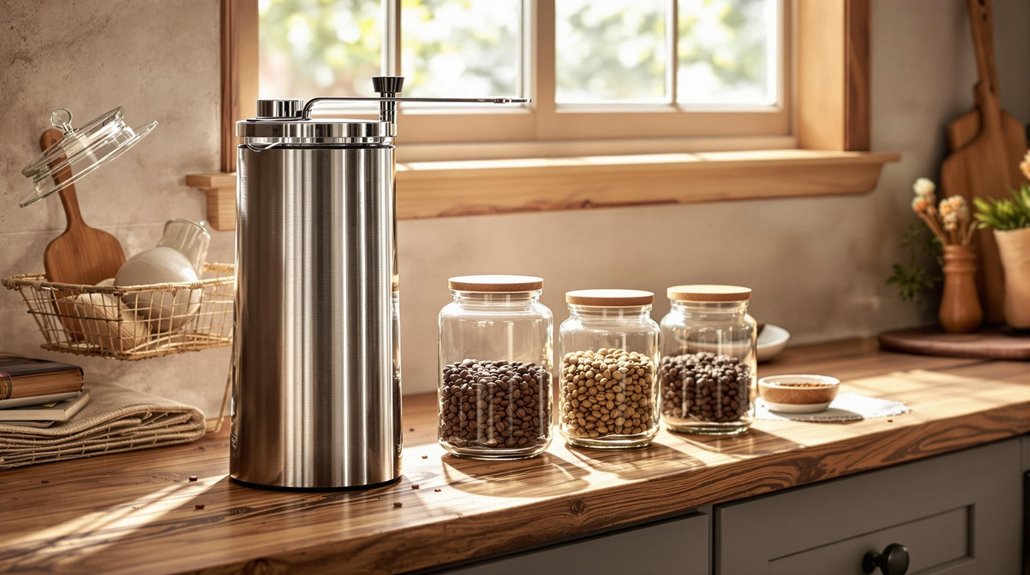
Capacity plays a pivotal role in choosing the right coffee grinder for your needs. When selecting a grinder, consider how much coffee you typically brew. If you regularly prepare multiple servings, a burr grinder with a hopper capacity of 1-12 cups is ideal. These grinders allow you to grind larger quantities of coffee beans at once, making them suitable for various brew methods. In contrast, blade grinders usually have smaller bowls, limiting their capacity to around 50-70 grams of coffee beans, which may not suffice for daily brewing if you enjoy multiple cups.
For most home users, a grinder with a capacity of 200-300 grams is often enough to meet daily demands. This size allows you to grind enough coffee for several cups without needing constant refills. If you operate a café or restaurant, you'll likely require a commercial grinder with a capacity exceeding 1 kilogram to handle high-volume demands efficiently. Some grinders even feature automatic dosing technology, adjusting grind time based on your desired number of cups or shots, optimizing capacity usage. Ultimately, your choice should align with your brewing habits and the size of your coffee-drinking audience.
Assessing Grinder Settings
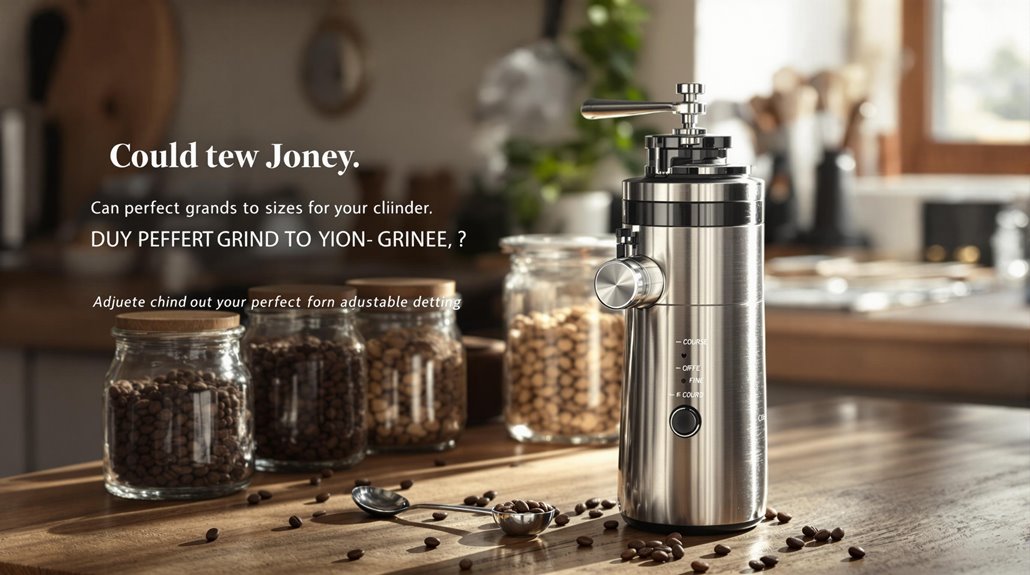
Grinder settings are vital for achieving the perfect cup of coffee, as they directly influence the extraction process. Depending on your brewing method, you'll need to adjust the grind size accordingly. For instance, espresso requires a fine grind, while a French press calls for a coarser texture.
When choosing a grinder, consider the grind range available. Burr grinders typically offer 70+ adjustable settings, allowing you to customize your grind settings for various brewing techniques. If you prefer more precision, a stepless grinder provides infinite grind adjustment, which is ideal for those who want exact grind consistency.
For convenience, look for features like programmable timed grinding, such as those found on the Baratza Vario, which allows you to set the amount of coffee based on your needs. This model features a dual cam grind adjustment system with 230 settings for both macro and micro adjustments, ensuring you achieve the right grind size quickly.
Ultimately, evaluating grinder settings is pivotal in your coffee journey. Proper adjustments will enhance flavor extraction and elevate your coffee experience.
Evaluating Speed and Noise
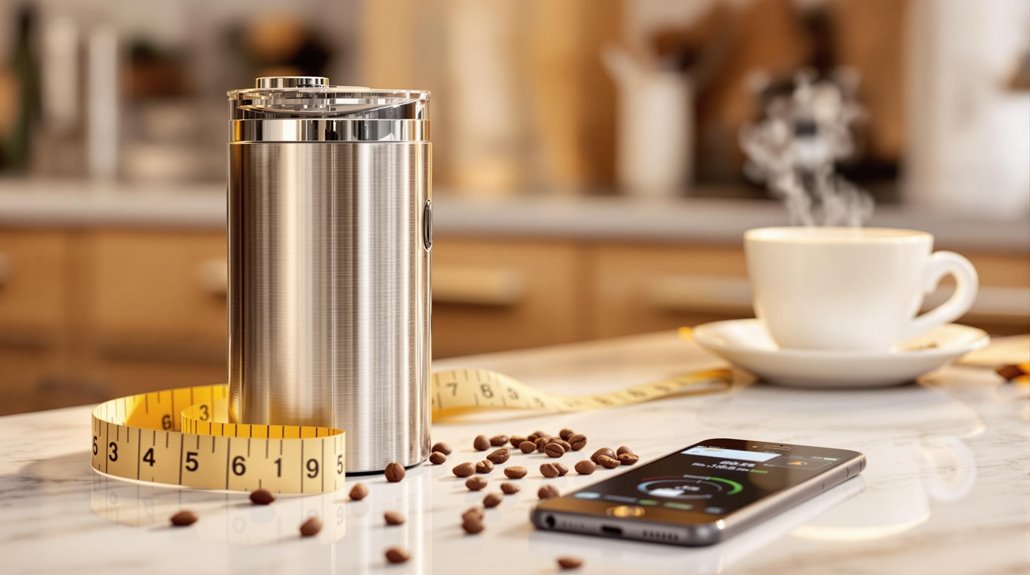
When choosing a coffee grinder, consider both speed and noise levels. Low-speed burr grinders, operating under 500 RPM, minimize heat and noise, preserving your coffee's flavor. In contrast, high-speed options can disrupt your environment and compromise coffee quality with excessive heat and louder operation.
Grinder Speed Considerations
The choice of grinder speed greatly impacts both the quality of your coffee and the noise level during preparation. Low-speed burr grinders, operating around 400 RPM, minimize heat and static, preserving the flavor and aroma of your beans. This slower grinding speed guarantees a consistent grind, which is essential for ideal extraction during brewing.
In contrast, high-speed grinders, exceeding 1,000 RPM, generate more noise and heat, which can degrade coffee quality and introduce bitterness. If you're considering burr grinders, conical models tend to operate at lower speeds compared to flat burr or blade grinders, making them quieter and more efficient for grinding coffee.
Blade grinders, however, are the loudest option available, as they operate at high speeds and produce significant heat during grinding. For the best results, it's advisable to choose a grinder with a speed under 500 RPM. This balance of grinder speed not only helps in maintaining a consistent grind but also keeps noise levels to a minimum, enhancing your overall coffee experience. By carefully considering these factors, you'll be better equipped to select the right coffee grinder for your needs.
Noise Level Assessment
At any time during your coffee preparation, noise level can substantially affect your experience. When choosing a coffee grinder, consider how the noise produced while grinding the beans impacts your brew. Low-speed burr grinders operate around 500 RPM, making them quieter and generating less heat compared to high-speed options, which often exceed 1,000 RPM and can produce significant noise, sometimes over 90 decibels. This increased noise and heat can degrade your coffee's flavor.
Among burr grinders, conical burrs are typically quieter than flat burrs due to their slower grinding speed. If you're looking for the quietest option, steer clear of blade grinders, which are the loudest, often exceeding 80 decibels during operation. Noise levels in coffee grinders can range from a manageable 60 decibels to unpleasantly loud levels, so it's crucial to assess what you can tolerate.
When evaluating grinders, factor in both the noise level and your preferred brewing environment. A quiet grinder enhances your coffee experience, allowing you to enjoy the process without added disturbance. Prioritize your comfort alongside performance for the best results in your daily brewing routine.
Design and Material Choices
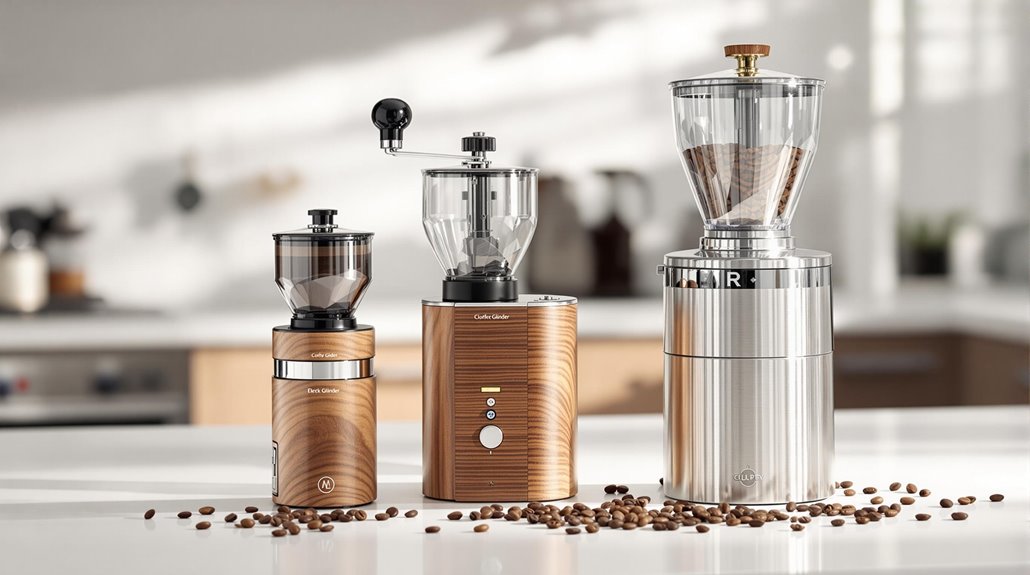
In selecting a coffee grinder, understanding design and material choices is essential for achieving peak performance and fitting your kitchen aesthetic. Stainless steel is the most common material for burrs and blades, providing durability and consistent performance. If you prefer something with heat resistance, consider ceramic burrs; however, keep in mind they can be brittle and may damage if foreign objects get in the grinder.
When space is limited, compact designs with stainless steel or plastic bodies are ideal, as they fit comfortably in smaller kitchens. If you're focused on grind quality and speed, larger burr sizes, such as 64mm or 80mm, can enhance performance but will increase the overall size of the grinder.
Aesthetic options are also vital. Look for matte finishes or sleek designs that can seamlessly blend with your kitchen decor. This attention to both functionality and style will guarantee that your coffee grinder not only performs well but also complements your kitchen environment. By carefully considering these design and material choices, you'll find a grinder that meets your needs and enhances your daily coffee experience.
Maintenance and Cleanup Tips
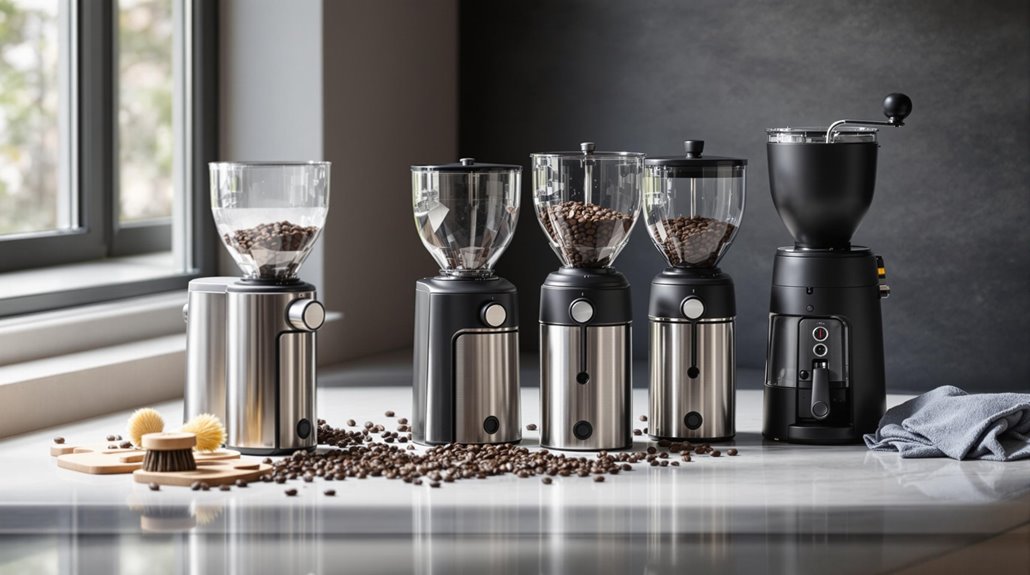
To keep your coffee grinder in top shape, establish a regular cleaning schedule that includes both surface maintenance and deep cleaning. Make sure you familiarize yourself with the easy disassembly process to access all components effectively. This approach not only enhances flavor but also guarantees consistent grind performance over time.
Regular Cleaning Schedule
While maintaining a regular cleaning schedule for your coffee grinder might seem tedious, it's essential for peak performance and flavor. A clean grinder guarantees that stale coffee residue and oil buildup don't compromise your grind quality. Aim to clean your grinder weekly by using a brush or vacuum to remove coffee grounds from the burrs and hopper after each use. This quick maintenance step keeps your grinder performing at its best.
For a deeper clean, disassemble the grinder monthly. Use a grinder cleaning solution or even rice to tackle stubborn oils that can accumulate on the burrs. This process not only enhances the longevity of your coffee grinder but also improves the flavor of your brews.
Don't forget to wipe down the exterior and hopper with a damp cloth to prevent dust and coffee particles from settling. Always check the manufacturer's guidelines for specific cleaning instructions, as this will help you avoid damaging any sensitive components during maintenance. By sticking to this cleaning schedule, you'll guarantee that your coffee grinder remains in excellent condition, delivering consistent grind quality with every use.
Easy Disassembly Process
A straightforward disassembly process is key to maintaining your coffee grinder effectively. Look for grinders equipped with removable burrs or blades; these features make cleaning and maintenance a breeze. Models with dishwasher-safe components can further simplify the disassembly and cleanup process, allowing you to keep your grinder in top shape with minimal effort.
When choosing a grinder, opt for those with fewer small parts. This reduction in complexity makes disassembly and reassembly quicker and more manageable. Additionally, consider grinders with accessible grind chambers. This design prevents coffee residue buildup over time, ensuring consistent performance and flavor.
Don't underestimate the importance of clear user manuals or online tutorials. These resources provide step-by-step guidance for safe and efficient disassembly, which is essential for thorough cleaning. By selecting a grinder that prioritizes easy maintenance, you'll not only extend its lifespan but also enhance your overall coffee experience. Remember, a well-maintained grinder leads to fresher coffee and better flavor extraction, so invest in a model that meets these criteria.
Budgeting for Your Grinder
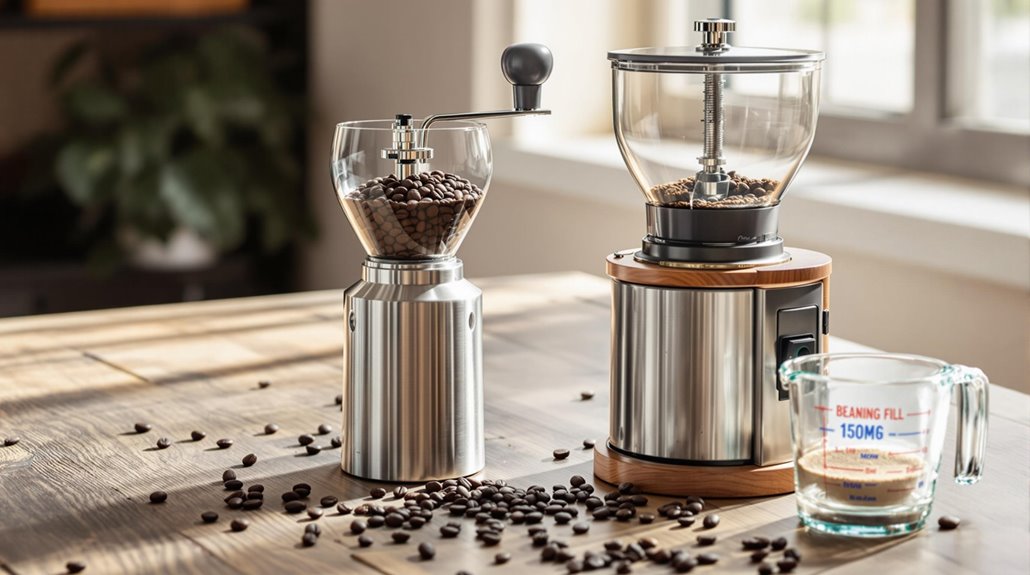
When budgeting for your coffee grinder, it's essential to evaluate both your brewing methods and long-term goals. A good grinder can greatly enhance your coffee experience, so consider what you want from your first grinder. Entry-level burr grinders like the Baratza Encore start at a price point of $159, providing durability and consistent grind quality, perfect for drip and pour-over methods.
If you're looking for versatility, mid-range options such as the Fellow Opus at $195 offer excellent value with adjustable grind settings suitable for both espresso and brewed coffee. For specialty coffee enthusiasts, high-end grinders like the Fellow Ode Gen 2, priced over $350, deliver superior performance with faster grinding speeds and 64mm flat burrs.
Alternatively, manual grinders like the 1ZPresso K-Max at $230 provide premium quality and portability, making them an appealing choice for precise grinding on the go. If you're on a tighter budget, consider options like the Timemore C3 at $79. While compact and travel-friendly, keep in mind that it may have limitations in grind consistency and capacity. Balancing your budget with your coffee goals is key to selecting the right grinder.
Recommendations for Different Users
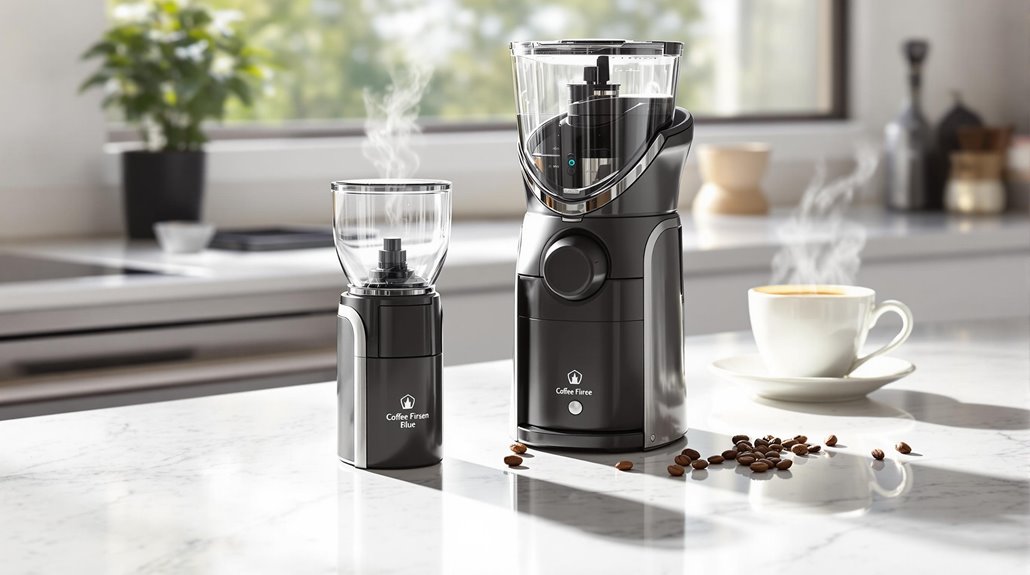
If you're just starting out, a grinder like the Fellow Opus offers the versatility you need without complicating your brewing process. For those with more experience, investing in a grinder with larger burrs, such as the Baratza Vario, allows for precise adjustments and consistent results. Understanding your coffee needs will guide you to the right grinder size and type.
Beginner-Friendly Options
Finding the right coffee grinder can seem overwhelming, but several beginner-friendly options cater to different brewing styles and budgets. The Baratza Encore is a solid choice at $159, offering durability and consistent grind quality, perfect for drip, pour-over, and French press enthusiasts. If you're exploring multiple brew methods, consider the Fellow Opus at $195. This versatile grinder works well for both espresso and brewed coffee, guaranteeing you get the perfect cup every time.
For those interested in manual grinding, the 1ZPresso K-Max at $230 provides precise grind settings and portability, allowing you to grind beans for espresso, pour-over, or cold brew. If you're on a budget, the Timemore Chestnut C3 is an excellent option at just $79. Compact and travel-friendly, it's perfect for grinding up to 25 grams of beans at a time.
Lastly, pour-over enthusiasts should check out the Fellow Ode Gen 2. Although it's priced over $350, its 64mm flat burrs and fast grinding capability guarantee consistent results, helping you brew exceptional coffee at home.
Advanced User Preferences
As you progress from beginner-friendly options to more advanced user preferences, selecting the right coffee grinder becomes increasingly important. If you're an espresso enthusiast, a grinder with 54mm ceramic burrs, like the Baratza Vario, is essential for precise grind adjustments and consistent particle size. Mid-level users aiming for espresso precision should consider the Ceados E5P or E6P series. These models feature 64mm steel burrs and stepless grind adjustments, allowing for tailored grind sizes ideal for your espresso machine.
For specialty coffee lovers, investing in high-end grinders such as the Niche or DF64 can enhance your brewing experience. These grinders offer superior build quality and grind consistency, making them perfect for both espresso and pour-over methods.
If you're budget-conscious yet still want quality, the Timemore C3 hand grinder is a compact and affordable option. It's suitable for drip, French press, and cold brew, ensuring you can enjoy great coffee without breaking the bank. Ultimately, your choice should reflect your brewing habits and the specific grind sizes you need for your favorite coffee methods.
Final Thoughts on Sizing
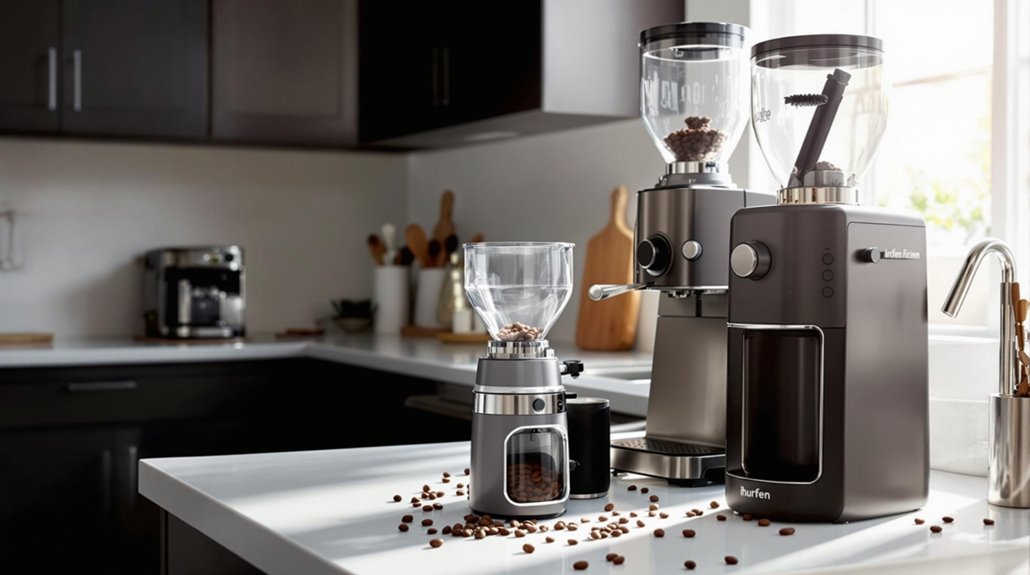
Selecting the appropriate coffee grinder size is essential for enhancing your brewing experience. When choosing a coffee grinder, consider your daily coffee consumption. If you regularly brew 12 cups, a larger hopper is ideal; for occasional use, a smaller hopper suffices. Think about your counter space, too. Compact grinders fit snugly in tight spaces, while larger models require more room.
The burr size greatly impacts performance. For home use, grinders with 40mm to 64mm burrs strike a balance between efficiency and storage. If you're brewing espresso, opt for a more robust grinder, as it demands precision for perfect coffee extraction.
Portable options like the Timemore C3 allow you to grind coffee on the go, while electric models like the Baratza Encore cater to larger capacities for home brewing.
Ultimately, aligning your grinder's size with your brewing method and lifestyle is vital. By focusing on these factors, you guarantee that your new coffee experience is tailored to your needs, allowing you to enjoy every cup. Choose wisely, and you'll access the full potential of your coffee journey.
Disclosure: As an Amazon Associate, I earn from qualifying purchases.
